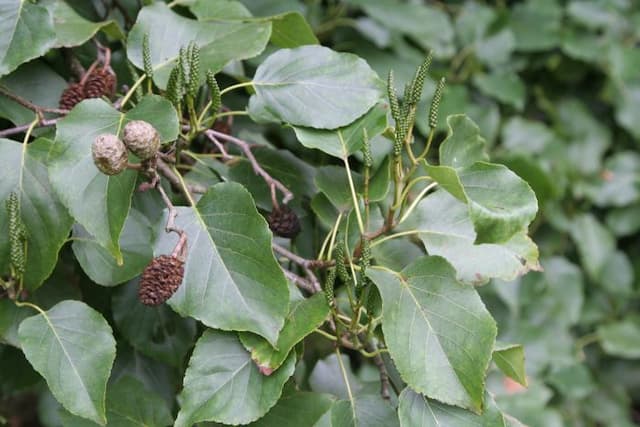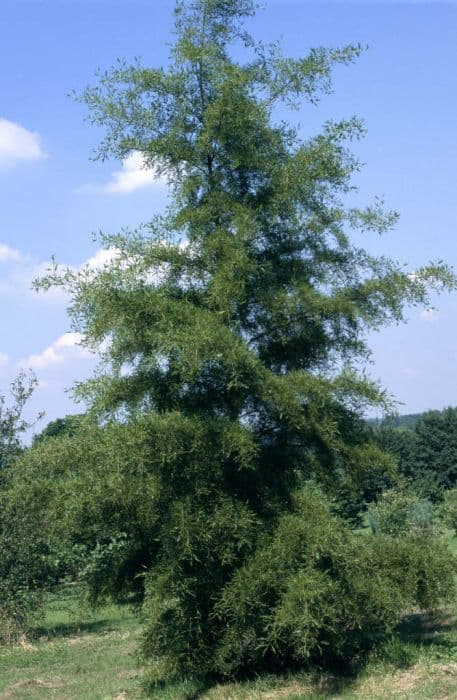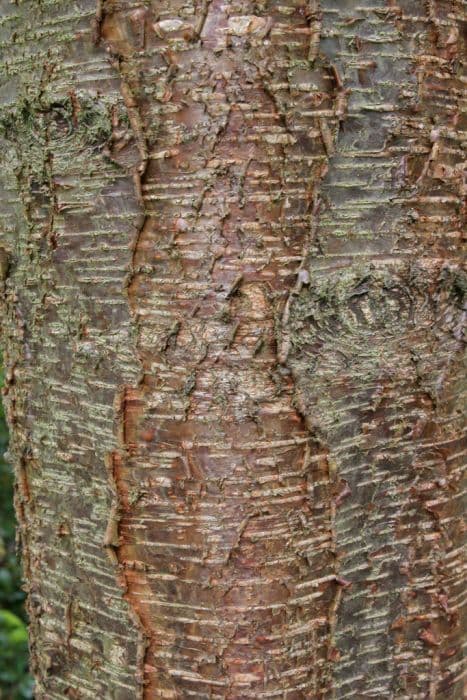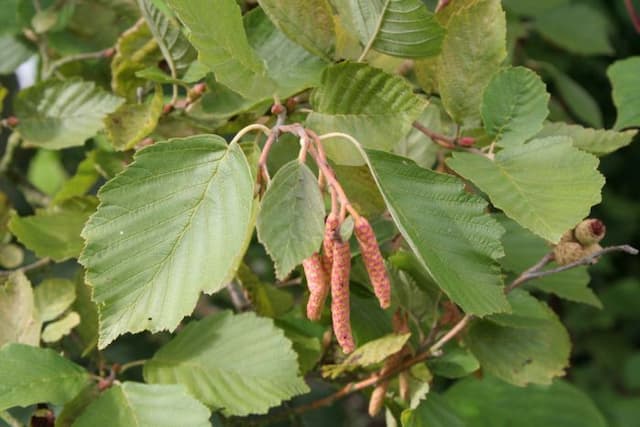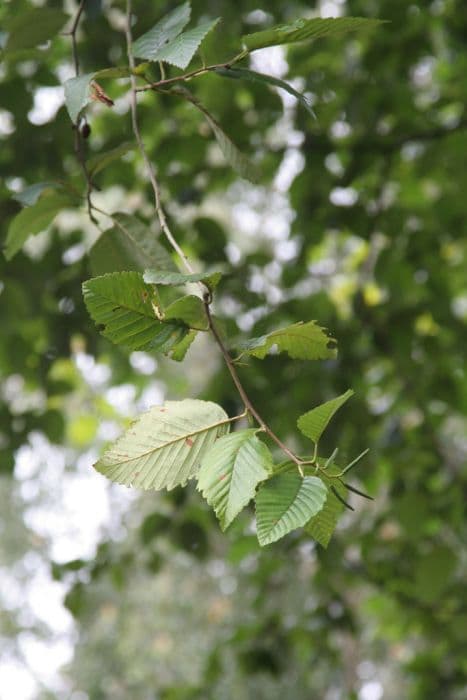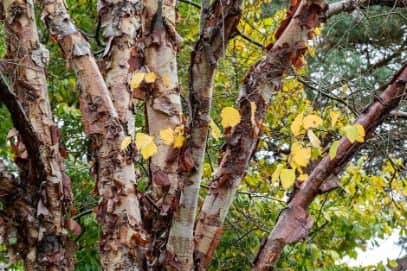Himalayan Birch Betula utilis subsp. utilis 'Park Wood'

ABOUT
The 'Park Wood' is known for its spectacular and ornamental bark, which is white and often peels in papery layers, creating an eye-catching texture. The bark's visual appeal lies in its smoothness and the contrasting black marks and horizontal lenticels that add to the tree's unique character. The leaves of the 'Park Wood' are oval to triangular in shape, with toothed margins that provide a delicate and intricate look. During the spring, the tree produces catkins, which are long and pendulous, adding a softness to its overall appearance. After the catkins, small winged seeds appear, which are wind-dispersed. The 'Park Wood' is appreciated in many settings for its graceful silhouette, with branches that may spread or ascend, creating a varying form that is both elegant and robust. It is a versatile addition to the landscape, often selected for its striking bark and pleasant canopy shape.
About this plant
 Names
NamesFamily
Betulaceae.
Synonyms
Himalayan Birch, Whitebarked Himalayan Birch, Jacquemontii Birch.
Common names
Betula jacquemontii, Betula utilis var. jacquemontii, Betula bhojpattra var. jacquemontii, Betula utilis var. albosinensis, Betula albosinensis.
 Toxicity
ToxicityTo humans
Himalayan birch is generally recognized as non-toxic to humans. There are no well-documented cases of poisoning from ingesting parts of this tree. However, as with many plants, individual allergies may exist, and caution is advised if someone is known to be sensitive to birch pollen or related allergens.
To pets
Himalayan birch is not known to be toxic to pets. There are no common reports of poisoning in pets such as dogs and cats from ingestion of parts of this tree. As with any non-food plant, ingestion of large quantities may cause gastrointestinal upset or an obstruction, so it's wise to prevent pets from chewing on branches or leaves.
 Characteristics
CharacteristicsLife cycle
Perennials
Foliage type
Deciduous
Color of leaves
Green
Height
30 feet (9 meters)
Spread
20 feet (6 meters)
Plant type
Tree
Hardiness zones
7
Native area
Himalayas
Benefits
 General Benefits
General Benefits- Ornamental Value: Betula utilis 'Park Wood', commonly known as the Himalayan Birch, is often used for its decorative white bark and graceful appearance.
- Shade Provider: The tree's canopy can offer shade and cooling properties, making it suitable for parks and gardens.
- Habitat for Wildlife: Birds and other wildlife may use the tree for nesting and as a source of food through its seeds and insects that inhabit the bark.
- Erosion Control: The root system can help stabilize soil and prevent erosion on sloped landscapes.
- Seasonal Interest: Offers visual interest throughout the seasons, from the peeling bark and spring catkins to the golden-yellow fall foliage.
- Drought Tolerance: Once established, it can be quite resilient to periods of low rainfall, making it suitable for various climates.
- Low Maintenance: Typically requires minimal care after establishment, making it an easy choice for both public landscapes and private gardens.
- Biodiversity Support: Supports ecological diversity by providing various microhabitats and food sources for a range of species.
 Medical Properties
Medical PropertiesThis plant is not used for medical purposes.
 Air-purifying Qualities
Air-purifying QualitiesThis plant is not specifically known for air purifying qualities.
 Other Uses
Other Uses- Woodworking: The wood from the Himalayan birch can be used to create small wooden items like utensils, and carved objects due to its fine grain and workability.
- Furniture Making: Because of its aesthetically pleasing bark, the wood is sometimes used to construct furniture, providing a unique and rustic look to the pieces.
- Ornamental Use: The peeling bark and attractive year-round appearance of the Himalayan birch make it popular as an ornamental tree in gardens and landscapes.
- Photography: The distinctive white bark and elegant form of the Himalayan birch offer an eye-catching subject for nature photographers, particularly in snowy landscapes.
- Tanning Leather: In traditional practices, the bark of the Himalayan birch, which is rich in tannins, was used in the leather tanning process.
- Handicraft Material: The bark, being fairly pliable and attractive, can be used in crafting decorative objects and even as a canvas for painting or writing.
- Outdoor Education: The tree serves as an educational tool in botany and dendrology to demonstrate adaptations to mountain environments in its native range.
- Natural Dyes: The bark and leaves of the Himalayan birch can be used to create natural dyes for fabrics and crafts, providing a range of colors depending on the mordant used.
- Ink Production: Historically, the sap of the birch may have been used as a base for making inks and paints, although this practice is not common today.
- Erosion Control: The Himalayan birch can be planted on slopes to help stabilize the soil and prevent erosion, thanks to its extensive root system.
Interesting Facts
 Feng Shui
Feng ShuiThe Himalayan Birch is not used in Feng Shui practice.
 Zodiac Sign Compitability
Zodiac Sign CompitabilityThe Himalayan Birch is not used in astrology practice.
 Plant Symbolism
Plant Symbolism- Adaptability: Betula utilis, commonly known as the Himalayan Birch, often grows in difficult conditions, signifying the ability to adapt and thrive in challenging environments.
- Purity: The white bark of the Himalayan Birch is often associated with purity and cleanliness, symbolizing a fresh start or a clean slate.
- New Beginnings: Trees in the Birch family, including Himalayan Birch, are typically among the first to colonize new or disturbed lands, making them emblems for new beginnings and rebirth.
- Renewal: The peeling bark of the Himalayan Birch represents renewal and the beauty of letting go of the old to make space for new growth.
- Protection: In some cultures, Birch trees are believed to ward off evil and negative energies, symbolizing protection and safety.
 Water
WaterThe Himalayan birch or Betula utilis 'Park Wood' prefers consistent moisture, so water deeply when the top couple of inches of soil feel dry. This typically means watering once or twice a week during dry periods, providing about 1 to 1.5 gallons per square yard each time, depending on the weather conditions and soil type. Over the course of a month, this can add up to about 4 to 6 gallons per square yard. Be cautious of overwatering as this plant does not like to sit in wet soil.
 Light
LightThe Himalayan birch prefers full sun to partial shade. It thrives best in a location that receives at least six hours of direct sunlight each day, but it can also tolerate some dappled shade, especially in the afternoon during the hottest part of the day.
 Temperature
TemperatureThe Himalayan birch can tolerate a wide range of temperatures and is hardy in zones 5 to 8. It can survive minimum temperatures down to -20°F and maximum temperatures typical of temperate regions. However, the ideal temperature range for this tree is between 60°F and 75°F.
 Pruning
PruningThe Himalayan birch requires minimal pruning which can be done to remove any dead, diseased, or damaged branches, or to shape the tree. Prune during late fall or winter when the tree is dormant. Annually check the tree to decide if pruning is necessary, as over-pruning can be detrimental.
 Cleaning
CleaningAs needed
 Soil
SoilThe Himalayan Birch thrives best in a well-drained, loamy soil mix with a slightly acidic to neutral pH of 6.0-7.5, rich in organic matter.
 Repotting
RepottingHimalayan Birches are typically outdoor trees and do not require repotting; in a garden setting, ensure adequate space for growth instead.
 Humidity & Misting
Humidity & MistingHimalayan Birch does not have specific humidity requirements, but it typically favors the conditions of its natural outdoor environment.
 Suitable locations
Suitable locationsIndoor
Not suitable for indoor growth due to large size and light needs.
Outdoor
Plant in well-drained soil, full sun to partial shade, and mulch.
Hardiness zone
5-8 USDA
 Life cycle
Life cycleBetula utilis, commonly known as Himalayan birch, starts its life as a seed that germinates in spring after dispersal by wind due to its lightweight and winged nature. The seedling emerges, establishing a root system and a shoot that will develop into a sapling. As the sapling grows, it undergoes a period of vigorous growth, usually for several years, until it reaches maturity. In maturity, the Himalayan birch will produce catkins that will be pollinated by the wind, leading to the development of seeds. After reaching its peak maturity, the tree may live for several decades, during which it will annually produce seeds to ensure the continuity of its species. Eventually, the tree will enter a senescence phase, where growth slows and it becomes more susceptible to environmental stresses, diseases, or pests, leading to its eventual death.
 Propogation
PropogationPropogation time
Spring-summer
The most popular method of propagation for the Himalayan Birch, Botanical name Betula utilis subsp. utilis 'Park Wood', is through the collection and sowing of seeds. The best time to collect seeds is when they mature in late summer to autumn. These seeds require stratification, which is a period of cold treatment to break dormancy; this process typically lasts for a couple of months. Following stratification, seeds are sown in trays filled with a well-draining soil mix and lightly covered. The trays should be kept in a cold frame or similar sheltered outdoor area during the winter until germination occurs in the spring after the frost has passed. Seedlings can then be hardened off and eventually transplanted into their permanent positions. This method takes advantage of the plant's natural reproductive cycle and requires patience, as it may take several years for the young trees to reach maturity.
